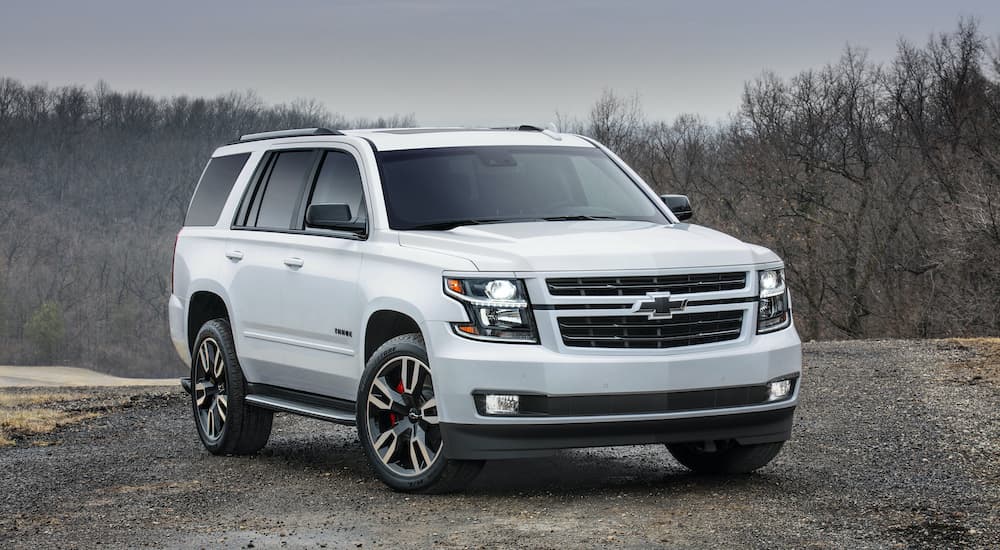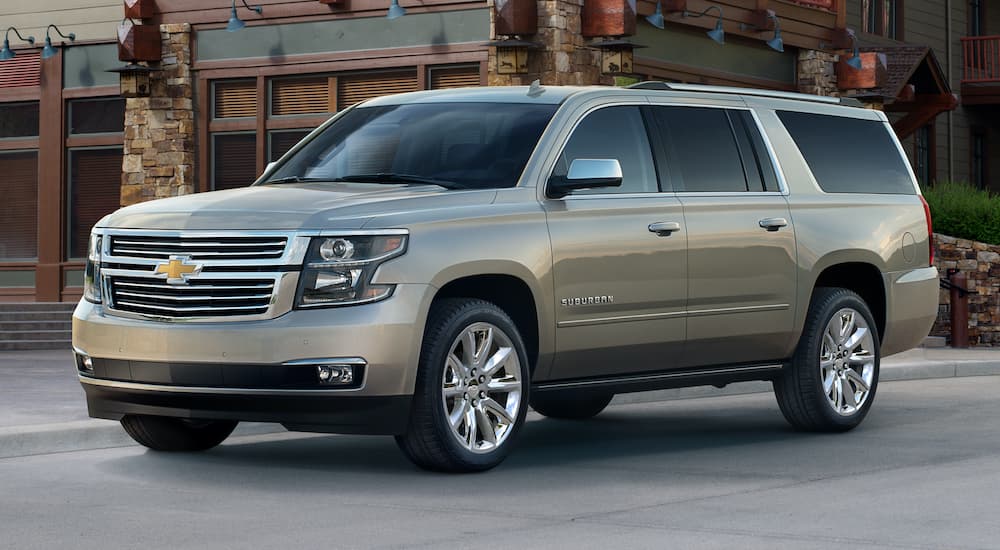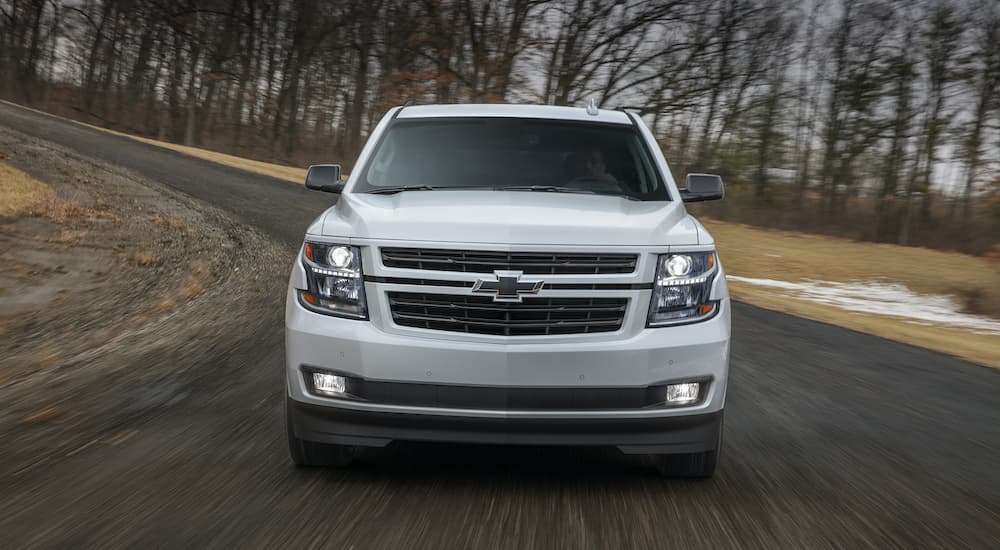Many a would-be buyer has scratched his head and pondered, “Exactly what is the difference between the Chevy Tahoe and the Chevy Suburban?” After all, they both offer three rows of seats and family-friendly cabin appointments like rear entertainment screens. But, as it turns out, these two large utes are very different. One trip to your used Chevy Tahoe dealer reveals how.
For starters, the Tahoe is smaller than the Suburban. The size difference is minimal but substantial enough to cause land yacht novices to opt for the Tahoe. If towing a boat or RV is in the cards, one model is a touch more capable. That’s why discerning the differences between these two popular SUVs requires a deep dive into each model’s spec sheet. Therein, the storyline pivots to size and size alone.
Large SUV buyers put a high premium on space, both for passengers and cargo. Still, for some, transitioning into the large SUV category comes with plenty of hand wringing. We recommend starting with your garage. Take a tape measure and make sure that whichever one you choose, you’ll have enough depth to park it. Deciding means knowing where the differences lie, and that’s what you’ll discover right here.
The Tahoe is Lighter
Families shopping for a more agile SUV should lean toward the Tahoe. Its dimensions alone mean you’ll have an easier time navigating streets and parking lots. Take the 2018 Tahoe, for example. Its curb weight is 5,356 pounds (2WD) and 5,631 pounds (4WD). The 2018 Suburban has a curb weight of 5,586 pounds (2WD) and 5,808 pounds (4WD). Still, even the heavier Suburban achieves identical max fuel economy ratings, at 16 mpg in the city and 23 mpg on the highway.
A lighter SUV means better towing capability, however. The 2018 Tahoe offers a max tow rating of 8,600 pounds, while the stockier Suburban hits a max rating of 8,300 pounds. While 300 pounds isn’t a substantial difference, most outdoor enthusiasts hauling a boat or RV will lean toward having the option of more capability, and since the Tahoe is lighter, it wins.
It makes sense. A typical 23-foot boat plus its trailer can weigh anywhere from 3,000 pounds to over 7,500 pounds. The same holds true for most RVs. Trucks and SUVs take a beating when they tow and haul heavy payloads; they can also suffer catastrophic powertrain damage when towing or hauling over the manufacturer’s stated limits. Picking an SUV with a capability buffer eliminates guesswork and minimizes risk.
Most experienced truck and SUV shoppers know that towing capacity varies based on the drivetrain, engine, and even the number of passengers and weight of the cargo on board. The 2018 Tahoe offers two available engines and either two-wheel or four-wheel drive. To achieve the max tow rating, you have to buy the lightest model, which in 2018 was the Tahoe 2WD with the smaller, 5.3-liter V8 engine.
The Suburban is Longer
Choose any model year Suburban and Tahoe to compare and you’ll find one constant, which is that the Suburban is bigger. The first and most apparent difference is overall length. In 2018, the Suburban measured 224.3 inches long, while the Tahoe measured 203.9 inches. The Suburban’s and the Tahoe’s wheelbases (the area between the front and rear tires) measured 130 inches and 116 inches, respectively.
Let’s break that down. First, because of its substantially longer wheelbase, the Suburban offers more passenger space, particularly in the third row. It also provides more cargo space. The numbers vary by model year, but the 2018 Suburban allows 39.3 cubic feet of cargo space behind the third row. The Tahoe’s cargo area measures 15.3 cubic feet, making its third-row cramped for adult-sized passengers.
Before you sign on the dotted line for a Suburban, ask yourself if you need the extra space because it comes with a lot more overall vehicle to manage. The Tahoe’s seats easily fold flat to expose additional cargo area, so hauling garden soil or oversized building materials from a big box store is still relatively easy. Still, if your family travels with tons of gear, the Tahoe may not be ideal. This is where lifestyle and habits play into your decision.
If you have a large family or find yourself with a full load of passengers more often than not, consider the Suburban. Carpools go more smoothly when third-row passengers don’t feel cramped. And, if your brood participates in gear-heavy after-school activities (e.g., football, lacrosse), opting for the larger Suburban is advisable. You may not need the extra space every day, but when it’s your turn to drive to the out-of-town football game, you’ll be glad you have it.
Tahoe vs. Suburban: How to Decide
We mentioned lifestyle already, but it bears repeating. This decision boils down to what you need. What does a typical day look like in your household? How do you spend your leisure time? Assuming your large SUV will serve as the primary family car, it’s important to choose based on which one you prefer to drive every day. The larger Suburban may simply feel too bulky.
Also, think logistics. Do you live in a congested urban area, or is your driveway or garage area limited? Space constraints can cause big headaches. Imagine having to rearrange your garage to accommodate a longer Suburban or deal with finding street parking or navigating an alley to reach your driveway. These are all considerations you should think through because shoehorning a massive SUV into a spot that’s better suited to a subcompact sedan will get old quickly.
Luckily, you don’t have to scrutinize fuel economy ratings or available comfort and convenience features to make your choice because both the Suburban and the Tahoe offer similar niceties, bundled logically within complementary trim lineups. This makes your choice more about size and towing capacity. To gain in one, you have to lose in the other. There’s an inverse relationship between size/weight and towing/hauling capability.
If you have three or more kids, you should consider a Suburban since someone will always be stuck in the back row. You can get either a Tahoe or a Suburban with a second-row bench seat, but do your children get along well enough to ride shoulder-to-shoulder on a weekend road trip? It’s highly unlikely. Conversely, if you’re hauling the family boat to your lake cottage all summer, the Tahoe makes the most sense.
Putting it All Together
Remember, while there are some differences between the Tahoe and the Suburban, they’re both large SUVs with massive amounts of passenger and cargo space. They don’t call them land yachts without good reason, so be prepared for added bulk. Chevy does a great job equipping both SUVs with surprisingly nimble road handling characteristics. You’re still operating a vehicle with high ground clearance and oversized proportions, though, so allow some time to get comfortable behind the wheel.
Best of all, driving a large SUV during the kid-rearing years makes the job infinitely easier. With room to stretch out, you’ll experience fewer sibling elbow jabs. Opt for a ute with a rear-seat entertainment system, and those family road trips become positively serene. Whether you have one kid or more, the large SUV lifestyle comes with tons of family perks, so fight that go-fast performance sedan urge, grab your captain’s hat, and enjoy your new land yacht.






